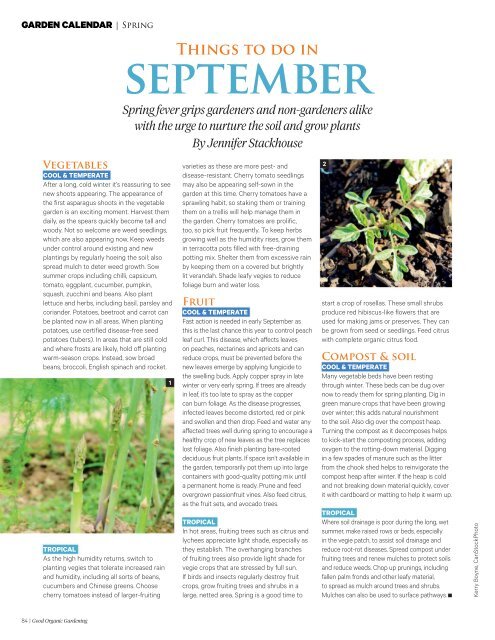5. Good Organic Gardening - September-October 2016 AvxHome.in
5. Good Organic Gardening - September-October 2016 AvxHome.in
5. Good Organic Gardening - September-October 2016 AvxHome.in
Create successful ePaper yourself
Turn your PDF publications into a flip-book with our unique Google optimized e-Paper software.
GARDEN CALENDAR | Spr<strong>in</strong>g<br />
Th<strong>in</strong>gs to do <strong>in</strong><br />
september<br />
Spr<strong>in</strong>g fever grips gardeners and non-gardeners alike<br />
with the urge to nurture the soil and grow plants<br />
By Jennifer Stackhouse<br />
Vegetables<br />
COOL & TEMPERATE<br />
After a long, cold w<strong>in</strong>ter it’s reassur<strong>in</strong>g to see<br />
new shoots appear<strong>in</strong>g. The appearance of<br />
the first asparagus shoots <strong>in</strong> the vegetable<br />
garden is an excit<strong>in</strong>g moment. Harvest them<br />
daily, as the spears quickly become tall and<br />
woody. Not so welcome are weed seedl<strong>in</strong>gs,<br />
which are also appear<strong>in</strong>g now. Keep weeds<br />
under control around exist<strong>in</strong>g and new<br />
plant<strong>in</strong>gs by regularly hoe<strong>in</strong>g the soil; also<br />
spread mulch to deter weed growth. Sow<br />
summer crops <strong>in</strong>clud<strong>in</strong>g chilli, capsicum,<br />
tomato, eggplant, cucumber, pumpk<strong>in</strong>,<br />
squash, zucch<strong>in</strong>i and beans. Also plant<br />
lettuce and herbs, <strong>in</strong>clud<strong>in</strong>g basil, parsley and<br />
coriander. Potatoes, beetroot and carrot can<br />
be planted now <strong>in</strong> all areas. When plant<strong>in</strong>g<br />
potatoes, use certified disease-free seed<br />
potatoes (tubers). In areas that are still cold<br />
and where frosts are likely, hold off plant<strong>in</strong>g<br />
warm-season crops. Instead, sow broad<br />
beans, broccoli, English sp<strong>in</strong>ach and rocket.<br />
TROPICAL<br />
As the high humidity returns, switch to<br />
plant<strong>in</strong>g vegies that tolerate <strong>in</strong>creased ra<strong>in</strong><br />
and humidity, <strong>in</strong>clud<strong>in</strong>g all sorts of beans,<br />
cucumbers and Ch<strong>in</strong>ese greens. Choose<br />
cherry tomatoes <strong>in</strong>stead of larger-fruit<strong>in</strong>g<br />
1<br />
varieties as these are more pest- and<br />
disease-resistant. Cherry tomato seedl<strong>in</strong>gs<br />
may also be appear<strong>in</strong>g self-sown <strong>in</strong> the<br />
garden at this time. Cherry tomatoes have a<br />
sprawl<strong>in</strong>g habit, so stak<strong>in</strong>g them or tra<strong>in</strong><strong>in</strong>g<br />
them on a trellis will help manage them <strong>in</strong><br />
the garden. Cherry tomatoes are prolific,<br />
too, so pick fruit frequently. To keep herbs<br />
grow<strong>in</strong>g well as the humidity rises, grow them<br />
<strong>in</strong> terracotta pots filled with free-dra<strong>in</strong><strong>in</strong>g<br />
pott<strong>in</strong>g mix. Shelter them from excessive ra<strong>in</strong><br />
by keep<strong>in</strong>g them on a covered but brightly<br />
lit verandah. Shade leafy vegies to reduce<br />
foliage burn and water loss.<br />
Fruit<br />
COOL & TEMPERATE<br />
Fast action is needed <strong>in</strong> early <strong>September</strong> as<br />
this is the last chance this year to control peach<br />
leaf curl. This disease, which affects leaves<br />
on peaches, nectar<strong>in</strong>es and apricots and can<br />
reduce crops, must be prevented before the<br />
new leaves emerge by apply<strong>in</strong>g fungicide to<br />
the swell<strong>in</strong>g buds. Apply copper spray <strong>in</strong> late<br />
w<strong>in</strong>ter or very early spr<strong>in</strong>g. If trees are already<br />
<strong>in</strong> leaf, it’s too late to spray as the copper<br />
can burn foliage. As the disease progresses,<br />
<strong>in</strong>fected leaves become distorted, red or p<strong>in</strong>k<br />
and swollen and then drop. Feed and water any<br />
affected trees well dur<strong>in</strong>g spr<strong>in</strong>g to encourage a<br />
healthy crop of new leaves as the tree replaces<br />
lost foliage. Also f<strong>in</strong>ish plant<strong>in</strong>g bare-rooted<br />
deciduous fruit plants. If space isn’t available <strong>in</strong><br />
the garden, temporarily pot them up <strong>in</strong>to large<br />
conta<strong>in</strong>ers with good-quality pott<strong>in</strong>g mix until<br />
a permanent home is ready. Prune and feed<br />
overgrown passionfruit v<strong>in</strong>es. Also feed citrus,<br />
as the fruit sets, and avocado trees.<br />
TROPICAL<br />
In hot areas, fruit<strong>in</strong>g trees such as citrus and<br />
lychees appreciate light shade, especially as<br />
they establish. The overhang<strong>in</strong>g branches<br />
of fruit<strong>in</strong>g trees also provide light shade for<br />
vegie crops that are stressed by full sun.<br />
If birds and <strong>in</strong>sects regularly destroy fruit<br />
crops, grow fruit<strong>in</strong>g trees and shrubs <strong>in</strong> a<br />
large, netted area. Spr<strong>in</strong>g is a good time to<br />
2<br />
start a crop of rosellas. These small shrubs<br />
produce red hibiscus-like flowers that are<br />
used for mak<strong>in</strong>g jams or preserves. They can<br />
be grown from seed or seedl<strong>in</strong>gs. Feed citrus<br />
with complete organic citrus food.<br />
Compost & soil<br />
COOL & TEMPERATE<br />
Many vegetable beds have been rest<strong>in</strong>g<br />
through w<strong>in</strong>ter. These beds can be dug over<br />
now to ready them for spr<strong>in</strong>g plant<strong>in</strong>g. Dig <strong>in</strong><br />
green manure crops that have been grow<strong>in</strong>g<br />
over w<strong>in</strong>ter; this adds natural nourishment<br />
to the soil. Also dig over the compost heap.<br />
Turn<strong>in</strong>g the compost as it decomposes helps<br />
to kick-start the compost<strong>in</strong>g process, add<strong>in</strong>g<br />
oxygen to the rott<strong>in</strong>g-down material. Digg<strong>in</strong>g<br />
<strong>in</strong> a few spades of manure such as the litter<br />
from the chook shed helps to re<strong>in</strong>vigorate the<br />
compost heap after w<strong>in</strong>ter. If the heap is cold<br />
and not break<strong>in</strong>g down material quickly, cover<br />
it with cardboard or matt<strong>in</strong>g to help it warm up.<br />
TROPICAL<br />
Where soil dra<strong>in</strong>age is poor dur<strong>in</strong>g the long, wet<br />
summer, make raised rows or beds, especially<br />
<strong>in</strong> the vegie patch, to assist soil dra<strong>in</strong>age and<br />
reduce root-rot diseases. Spread compost under<br />
fruit<strong>in</strong>g trees and renew mulches to protect soils<br />
and reduce weeds. Chop up prun<strong>in</strong>gs, <strong>in</strong>clud<strong>in</strong>g<br />
fallen palm fronds and other leafy material,<br />
to spread as mulch around trees and shrubs.<br />
Mulches can also be used to surface pathways .<br />
Kerry Boyne, CanStockPhoto<br />
84 | <strong>Good</strong> <strong>Organic</strong> <strong>Garden<strong>in</strong>g</strong>

















